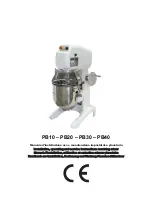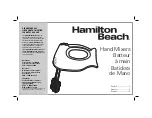
Manual-7
OPERATING INSTRUCTIONS
INITIAL OPERATION
Operation of the MP 24 is fairly straightforward, deviating
only slightly from other products of its type. Assuming at
least one turntable is connected and assigned to PHONO 1,
operation consists of the following: Make sure all faders are
set to zero, the MIC, LOOP, EQ, and CROSSFADER are all
disengaged, (switches out) and that all rotary LEVEL controls
are either fully CCW or in their center detents, whichever
applies. Select PHONO l on Input Channel 1. Simultaneously
raise the Channel 1 fader and the MASTER LEVEL fader.
Before much travel is reached on the faders, the results should
be heard. If not, shut everything down and recheck connec-
tions, power to the mixer (look for the yellow POWER light)
and ancillary devices (EQs, crossovers, amplfiers, etc.)
Once an output is established from the turntable, go ahead
and try everything else. Assign all Inputs to the Channels they
will be used, and test the system. Once all sources are set as
desired, proceed.
REAR PANEL ADJUSTMENTS
There are some controls on the rear panel which need to
be set. Set the METER SENSITIVITY ADJUST so the
system is at maximum level, (usually just short of amplifier
clipping). Run the system up to this maximum level and turn
the METER SENSITIVITY ADJUST so that the highest
peaks on the PEAK PROGRAM METER occasionally hit the
+8 dB indicator. This warns the operator that further pressure
on the throttle will overdrive the system.
At this point check the MAXIMUM OUTPUT GAIN
REDUCTION control so that with the MASTER LEVEL at
“10”, the meter responds as it did in the previous step. This
would be a good time to make the adjustment. This may be
accomplished by turning the rear panel MAX OUTPUT
GAIN REDUCTION adjustment all the way down, pushing
the MASTER LEVEL fader all the way up, setting a normal
mix level on the Input fader, and then turning up the MAX
OUTPUT GAIN REDUCTION adjustment on the rear until
the required output level is attained. In some cases, make this
adjustment with both the Source Level and the MASTER
LEVEL faders all the way up. This is acceptable only if
sources can be adjusted such that they all have equal output
before they reach the Input of the MP 24. If this is not
possible, full system drive will not come from some compo-
nents. To accomplish this feat, identical cartridges in all
turntables are required so the phono levels are all the same.
Having done all of this it is possible to use the MAX OUT-
PUT GAIN REDUCTION on all of your sources.
The other rear panel adjustment that should be made at
this time has to do with the maximum deviation to the
frequency response of the system left to the operator. This is
controlled by the EQ RANGE switch. In the out position, the
range of all of the EQ controls is ±8 dB. In the in position,
this range is reduced to ±4 dB. The latter is considered safer
in situations where taste makes waste—in drivers, that is.
THE HEADPHONE CONTROL (CUE) SYSTEM
To use the HEADPHONE CUE System, signal must be
present at one of the Inputs. (Well, at least you do to make
sure it works.) Depressing the CUE switch for the respective
Input Channel presents this signal to the Headphone Cue
amplifier. An LED illuminates next to the CUE switch,
attesting to the fact that it was indeed pushed down. Now
select how to listen to it — Mono Cue in one ear, Mono
Program in the other, Stereo Program in both ears, or Stereo
Cue in both ears. The STEREO/MONO CUE switch allows
this flexibility. To vary the level between Cue and Program,
rotate the HEADPHONE PAN control in the desired direc-
tion. CCW rotation increases the Cue Level, CW rotation
increases the Program Level. The overall volume of all of this
is then controlled by the rotary HEADPHONE LEVEL
control.
USING THE ASSIGNABLE CROSSFADE
First, press the Crossfade ENGAGE switch. The green
LED next to the switch illuminates. The Crossfade ASSIGN
switches determine the two Input Channels that are mixed by
the Crossfader. As an example, assume the left ASSIGN
switch is set on 1 and the right ASSIGN switch is on 2. This
activates both mix faders on Channels 1 and 2. Their outputs,
however, are under the control of the Crossfader. When in its
left-most position, only Channel 1 appears at the Outputs.
Both Channels are present in equal levels in the when the
Crossfader is brought to the middle, and only Channel 2 is
heard once the far right is reached. Note that the sound
pressure level does not change as this transition is effected.
This is a constant power Crossfader, meaning that if the two
input signals are equal, a steady volume level is maintained
no matter where the Crossfader is positioned. This, of course,
gets a bit sticky to predict when one song may be in fade-out
as the operator crossfades from one to the next which is
building in volume.
Once crossfaded to Channel 2, maybe cue up some video
and put the audio on Channel 4. Hard to do? No way. Simply
pull the Channel 1 fader to zero, set the ASSIGN switch on
the left of the Crossfader to Channel 4, Cue up 4, set the level
on fader 4 and Crossfade into it. We realize that it’s a bit
strange to Crossfade from 2 to 4 by sliding the fader to the
left, however it’s just an unavoidable oddity caused by having
so much flexibility.
MICROPHONE OPERATION
To use the mic, connect it to the appropriate connector,
and set the PHANTOM POWER switch to the desired mode
(it’s a good idea to have the Phantom Power in the on position
for condenser mics, off for dynamics). Leave the MASTER
LEVEL fader in roughly the same location as it was for the
music that’s been playing, press the MIC ENGAGE switch
and slowly adjust the MAIN MIC (or AUX MIC) LEVEL.
Once this has been accomplished, the tonal balance may be
adjusted via the MIC EQ controls located above the LEVEL


























